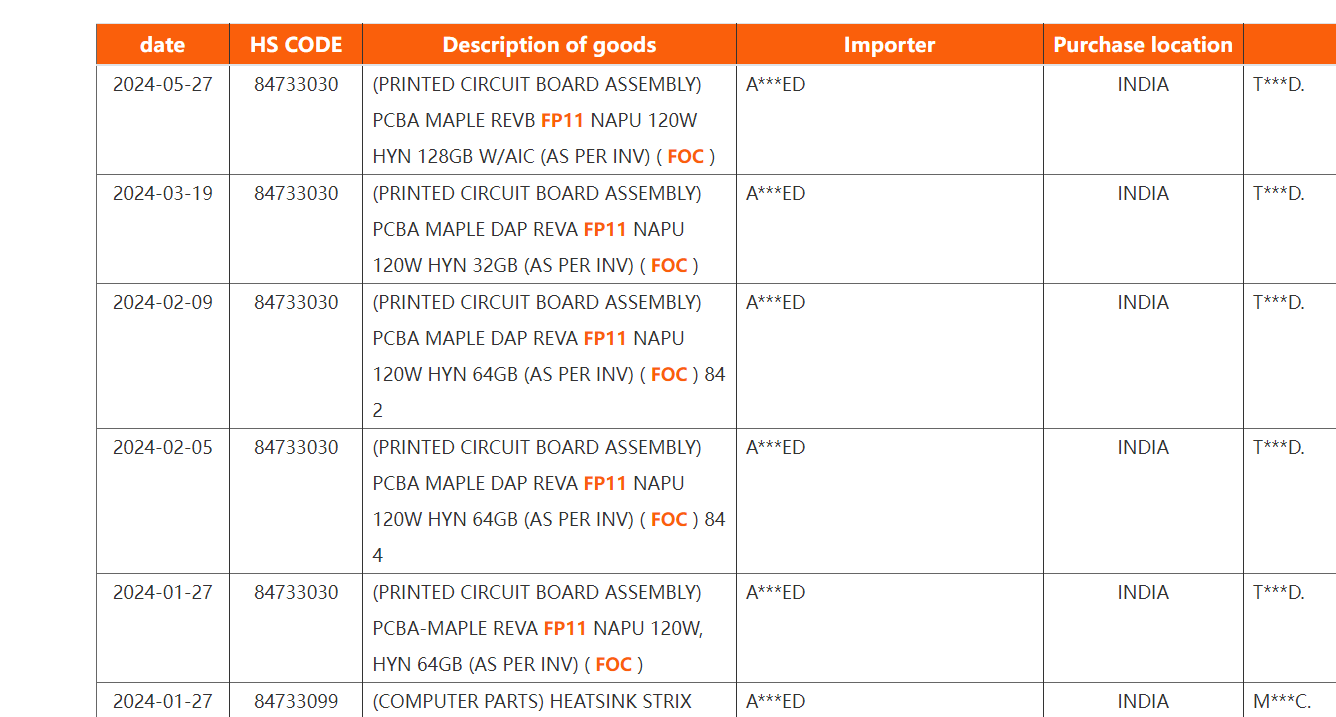AMD's Strix Halo being tested with 128GB RAM — shipping records reveal more about extreme 120W APU
Strix Halo gets beefier every time we see it.

Another shipping manifest containing information on printed circuit boards reveals an even more extreme variant of the rumored AMD Strix Halo APU in the wild. The mobile processor is already threatening to be the beefiest APUs AMD has ever produced, mobile or otherwise, and has now been spotted paired with 128GB of onboard RAM.
Customs data tracking site NewBid Data revealed a new shipment of Maple Rev.B PCBs shipped on May 27, though tech news outlets have only spotted the manifest today. The "Maple" circuit board assembly has been previously associated with Strix Halo test boards, with Maple Rev.A being the name of the PCBA of previously reported Strix Halo boards with 32GB and 64GB of RAM. The 120W TDP of the chip from previous revisions remains on the newest variant.
The possibility of 128GB of RAM has made Strix Halo an even more exciting product. By way of a disclaimer, AMD has never officially confirmed the existence of Strix Halo, though months of leaks have led most to treat it as fact. Sharing a name with Strix Point, the internal codename for AMD's Ryzen AI 300 series of mobile processors launching in laptops in July, Strix Halo's currently leaked form seems stronger than AMD's current-gen APUs powering PlayStations and Xboxes.
The Strix Halo APU is expected to be a multi-chip package thanks to the die-to-die Infinity Fabric interconnection AMD is known for. Two separate CPU dies will live on the chip together with a GPU die; the CPU portion of the APU will be 16 Zen 5 cores that turbo up to 5.8 GHz with a 64MB L3 cache, while graphics will be powered by up to 40 RDNA 3.5 cores at 16x PCIe 4.0 speeds. The processing and graphics will also share a 32MB L4 "Infinity" cache. Strix Halo will also reportedly come with a NPU capable of 70 TOPS, breezing past today's "AI PC" minimum spec.
We considered 64GB RAM to be overkill when we first saw Maple test boards shipping with it onboard, so 128GB and 120W TDP truly feel like excess for gaming applications. The extreme TDP and RAM are likely for speculative testing to push the APU to its extreme limits and see how it performs when supercharged with huge power draw and huge tracts of RAM. However, it is still possible that these are the top-end specs AMD will ship Strix Halo with. Halo has been associated with power users and prosumers who may use the chip for content creation, AI workloads, 3D rendering, and other demanding applications. With its beefy specs and self-contained footprint, Strix Halo will fit within much slimmer machines than a comparable CPU/mobile GPU combo. Many speculate that Strix Halo will be seen inside a handheld gaming PC.
We have no confirmed launch date for Strix Halo products or even official confirmation of the chip's existence. We'll get our first taste of Zen 5 architecture when Strix Point comes out in July, and hopefully, Strix Halo will be quick to follow.
Get Tom's Hardware's best news and in-depth reviews, straight to your inbox.

Sunny Grimm is a contributing writer for Tom's Hardware. He has been building and breaking computers since 2017, serving as the resident youngster at Tom's. From APUs to RGB, Sunny has a handle on all the latest tech news.
-
Reply
The mobile processor is already threatening to be the beefiest APUs AMD has ever produced, mobile or otherwise, and has now been spotted paired with 128GB of onboard RAM.
Which memory are you referring to here ? Those are NOT on-package memory modules.
128 GB memory is definitely not on-board or on-package like Intel's Lunar Lake, but we are most likely looking at soldered designs.
Customs data tracking site NewBid Data revealed a new shipment of Maple Rev.B PCBs shipped on May 27, though tech news outlets have only spotted the manifest today. The "Maple" circuit board assembly has been previously associated with Strix Halo test boards
That's the "Maple DAP" reference evaluation and testing platform. I wouldn't refer it as any PCB or board. Strix HALO will also support the FP11 socket platform, with TDPs ranging from 55W and up to 130W. -
A very confusingly written article.Reply
The processing and graphics will also share a 32MB L4 "Infinity" cache.
To be clear, that's called MALL cache for the iGPU. There will be an additional 32 MB of MALL cache onboard the IOD that will be eliminating bandwidth bottlenecks for the iGPU.
Strix Halo APU will add a 32MB MALL cache to the SoC. Its function is similar to the current Infinity Cache, which can reduce the use of memory bandwidth and improve GPU performance.
Strix Halo will also reportedly come with a NPU capable of 70 TOPS,
Sorry, it is max up to 60 TOPS. Here is proof from AMD's own slide.
https://cdn.wccftech.com/wp-content/uploads/2024/04/AMD-Strix-Point-Zen-5-Ryzen-APU-Leak-Rumor-Official-Docs.jpeg
The extreme TDP and RAM are likely for speculative testing to push the APU to its extreme limits and see how it performs when supercharged with huge power draw and huge tracts of RAM. However, it is still possible that these are the top-end specs AMD will ship Strix Halo with.
They are not pushing anything to the limit. These are indeed high-end Strix Halo parts like you mentioned, because HALO was supposed to be the flagship APU lineup from AMD, targeting the ultra enthusiast segment.
Strix Halo will fit within much slimmer machines than a comparable CPU/mobile GPU combo. Many speculate that Strix Halo will be seen inside a handheld gaming PC.
What ? Slimmer machines and handhelds with Strix Halo ? Seems unlikely, and out of equation since these are high-end SKUs. For handheld devices, AMD has a different APU lineup in the pipeline, like e.g "Kraken Point", having a 4 Zen 5 and 4 Zen 5C core configuration.
AMD also had some lower-end parts in the 'Strix Halo' lineup like some rumors pointed out before, but those were later debunked. -
TechyIT223 +1 for the above input.Reply
I want an Asus G14 with this processor. The current chassis while being thin only has a 1.5KG weight, has no problem pushing up to 80w+100W watts to the 8845HS CPU and 4070M GPU.
HALO would make it the perfect high-end laptop.
Having 2 CCDs and 16-cores will certainly help professionals and any CPU-centric workloads or a combination of CPU/GPU work. I just hope it's not the only configuration. -
thestryker Since this is a test platform that's probably why we're seeing 128GB capacity though with the 256-bit bus it's not impossible that could be a shipping configuration. I don't know enough about OEM memory IC pricing and board pricing to say for sure but it's possible 8x 32-bit packages with lower capacity and ball count end up being a net win.Reply -
usertests Reply
There have been conflicting leaks for the NPU TOPS in Strix Halo, including the 70 one. At this point, who cares? We can be pretty sure that it will be a little higher than Strix Point, like Hawk Point compared to Phoenix, which is simply from higher (default) clock speeds.Metal Messiah. said:Sorry, it is max up to 60 TOPS. Here is proof from AMD's own slide. -
The TOPS value shouldn't matter much for gamers though anyway. The 70 TOPS value has not been confirmed by AMD yet.Reply
In any case, I just hope these APUs are powerful enough to provide decent discrete GPU level gaming performance, especially the top-end part sporting 40 CUs, without any throttling as well.
There is speculation that the flagship APU might also offer performance equivalent to that of an RTX 4060/70 GPU , though I wouldn't place my bet on this claim yet. -
jtuck9 Reply
I'm wondering (hoping) that they'll leverage these NPU's to compete with the NVIDIA software suite, upscaling (DisplayPort 2.1 UHBR10 output) etc, allowing them to punch above their weight. Especially considering the direction of the upcoming Windows 11 (12?!) update.Metal Messiah. said:The TOPS value shouldn't matter much for gamers though anyway. The 70 TOPS value has not been confirmed by AMD yet.
In any case, I just hope these APUs are powerful enough to provide decent discrete GPU level gaming performance, especially the top-end part sporting 40 CUs, without any throttling as well.
There is speculation that the flagship APU might also offer performance equivalent to that of an RTX 4060/70 GPU , though I wouldn't place my bet on this claim yet. -
usertests Reply
I hope the 256-bit memory bus becomes a trend. It seems like a successor to Strix Halo is planned, and in general it would be nice to see AM6 go quad-channel to give desktop APUs the kick they need.Metal Messiah. said:In any case, I just hope these APUs are powerful enough to provide decent discrete GPU level gaming performance, especially the top-end part sporting 40 CUs, without any throttling as well.
There is speculation that the flagship APU might also offer performance equivalent to that of an RTX 4060/70 GPU , though I wouldn't place my bet on this claim yet. -
jtuck9 Reply
It will be interesting to see how the "AI Craze May Have Nerfed AMD’s & Intel’s Upcoming Chips" plays out...usertests said:I hope the 256-bit memory bus becomes a trend. It seems like a successor to Strix Halo is planned, and in general it would be nice to see AM6 go quad-channel to give desktop APUs the kick they need.
I'd buy a system with one of these chips in regardless, but as I'm looking at cloud gaming and it looks like upscaling using Geforce Now is tied solely to Nvidia hardware, if that's still a thing?! It's something I'll have to factor in going forward. -
usertests Reply
The blame can be shifted onto Microsoft. Cool claim by uzzi about the cancelled cache, but AMD hasn't shown any obvious interest in unifying (reunifying?) L3/L4 cache for CPU and iGPU. Maybe in a patent somewhere? AMD has always been stingy with L3 cache on mainstream APUs. Remember how Renoir had a whopping 4 MiB per CCX?jtuck9 said:It will be interesting to see how the "AI Craze May Have Nerfed AMD’s & Intel’s Upcoming Chips" plays out...
There are many directions AMD could go with their mainstream APUs, but we should have come to expect disappointment by now. Strix Halo breaks APUs out of the mainstream and into enthusiast territory with the larger size, 256-bit memory, and Infinity Cache. It can't be put onto AM5 but we could cope with it being soldered to a motherboard.
